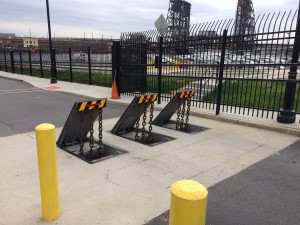The Only Guide for Wedge Barriers
Table of ContentsRumored Buzz on Wedge BarriersWedge Barriers for Dummies

Wedge Barriers for Beginners
The remaining force used to
the cam to deploy release wedge plate 16 may might provided supplied an electromechanical actuator 84 or other actuator. The springtime setting up 54 and the actuator 84(e. Wedge Barriers. g., electromechanical actuator)may run together to equate the cam and lift the wedge plate 16.
As stated above, the spring setting up 54 applies a consistent pressure on the webcam, while the electromechanical actuator might be controlled to put in a variable force on the cam, therefore allowing the lifting and decreasing( i. e., releasing and retracting )of the wedge plate 16. In particular personifications, the consistent pressure applied by the springtime setting up 54 may be flexible. g., electromechanical actuator) is disabled. As will be appreciated, the springtime setting up 54 may be covered and secured from debris or other elements by a cover plate(e. g., cover plate 68 revealed in FIG. 4) that may be substantially flush with the raised surface area 38 of the structure 14. As mentioned above, in the deployed placement, the wedge plate 16 offers to obstruct access or travel beyond the obstacle 10. For instance, the barrier 10(e. g., the wedge plate 16 )may block pedestrians or vehicles from accessing a property or pathway. As discussed above, the obstacle 10 is affixed to the support 30 protected within the foundation 14,

front braces 71. Consequently, the linkage assemblies 72 might pivot and rotate to enable the collapse and extension of the linkage settings up 72 during retraction and implementation of the bather 10. The linkage assemblies 72 reason movement of the wedge plate 16 to be restricted. For instance, if a lorry is traveling in the direction of the deployed wedge plate 16(e. As an example, in one condition, the security legs 86 might be prolonged throughoutupkeep of the barrier 10. When the safety and security legs 86 are deployed, the security legs 86 sustain the weight of the wedge plate 16 against the surface 12. As an outcome, the visit this web-site lifting device 50 may be shut off, serviced, removed, replaced, and so forth. FIG. 5 is partial perspective sight of an embodiment of the surface-mounted wedge-style obstacle 10, highlighting the web cam 80 and the webcam surface areas 82 of the lifting mechanism 50. Especially, 2 webcam surface areas 82, which are described as reduced camera surfaces 83, are positioned below the web cam 80. The lower webcam surfaces 83 may be taken care of to the surface area 12 (e. For instance, the reduced camera surface areas 83 and the placing plate 85 might form a single item that is protected to the anchor 30 by screws or other mechanical fasteners. In addition, 2 webcam surface areas 82, which are referred to as top web cam surfaces 87, are placed over the cam 80 and combined to (e. In other embodiments, intervening layers or plates might be placed in between the surface 12 and the lower camera surface areas 83 and/or the wedge plate 16 and the upper cam surfaces 87 As mentioned over, the cam
80 converts along the cam surfaces 82 when the wedge plate 16 is lifted from the pulled back setting to the released setting. In addition, as discussed above, the springtime assembly 54 (see FIG. 3 click here to find out more )might give a pressure acting on the cam 80 in the instructions 102 using springtime pole 58, which may lower the force the electromechanical actuator 84 is called for to relate to the camera 80 in order to activate and raise the wedge plate 16. 1 )to the released setting(see FIG. 4). As shown, the webcam 80 includes track wheels 104(e. g., rollers), which contact and equate along the cam surfaces 82 throughout operation.